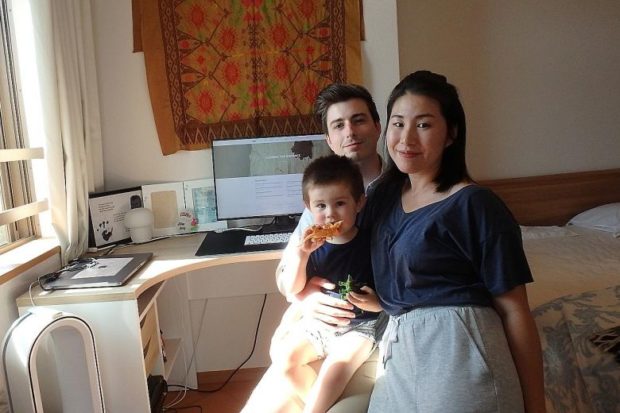
Norwegian John Edvard, seen here with his Japanese wife and their son at his workspace in their Fukuoka home, says flexiwork has enabled him to “work in batches”. COURTESY OF JOHN EDVARD via The Straits Times/Asia News Network
TOKYO — The nightmare of Tokyo’s morning rush-hour trains is something that Ms Yayoi Yakumo says she will not miss, as the human resources manager has embraced the experience of working from home.
The 44-year-old, who works at building materials group Lixil, will continue to work from home even as Japan last week lifted its state of emergency, with many large corporations having adopted flexible telework arrangements that years of government cajoling had failed to achieve.
A Tokyo Metropolitan Government (TMG) study shows that 63 percent of companies in the capital had telework arrangements last month, up from 24 per cent in March.
But another survey by human resources firm Kaonavi shows that just 35.5 percent of companies across Japan practice teleworking, suggesting that the take-up rate has been inconsistent between regions.
In any case, major organizations have arguably had an easier time transitioning to telework, having long laid the groundwork with trial runs before the pandemic.
Ms Yakumo tells The Sunday Times that she was working from home up to twice a week before Covid-19 struck.
“Now, since we are always at home together, I feel like I’ve become an employee, a manager, a mother, a teacher, and a cleaner all at the same time,” she says.
The mother of two children of elementary school age, however, quickly adds that she relishes being able to spend more time with her family, though “it has taken some getting used to in order to keep my work and personal lives separate”.
A Lixil spokesman said the company, which employs 75,000 people worldwide, will cap the number of staff in its office to 40 per cent of the maximum capacity to ensure proper social distancing.
This is set to be a new reality elsewhere as well.
A TMG spokesman told The Sunday Times that telework will continue, with the goal of having just 20 percent of its employees – excluding those involved in Covid-19 measures or essential citizen services – commute to work.
TMG is advising businesses to take steps such as using plastic sheets as separators where people are expected to meet, and encouraging other measures such as off-peak commuting.
Fujitsu is limiting the maximum number of employees in its offices to 25 percent of the capacity, with telework to be the “default working style”.
Fujitsu president Takahito Tokita said in a message to employees last week: “In the past, we took for granted many business trips, face-to-face events, regular meetings, and so on. The starting point for all such interactions will now be to consider online as the first option.”
Hitachi senior vice-president Hidenobu Nakahata told reporters last week that the company aims to have just 50 per cent of its 33,000 staff in Japan report to work from April next year.
This will build on the experience of the Covid-19 pandemic, during which 70 per cent of its headcount worked from home, except those involved in off-site work.
Mr Nakahata also said the company will pay a monthly stipend of 3,000 yen (S$39) to cover costs arising from telework, while subsidizing the purchase of work-related equipment.
Telecommunications conglomerate NTT, which employs 180,000 people across its 280 companies, is also aiming to have just half its headcount at its offices, the Nikkei said.
Nearly 60 per cent of its staff worked from home during the state of emergency – a figure that rises to 90 per cent for office workers alone.
Some others, such as mobile messaging firm Line Corporation, plan to have employees gradually return to the office.
Line is rolling out a trial period from June 8 until end-July, with safeguards in place. Employees are expected to wear masks, while meetings are to be limited to under half of the room capacity and under 30 minutes.
The firm gave a monthly stipend of 5,000 yen to cover associated costs, as well as “special paid leave” to parents who have to look after children cooped up at home.
Fukuoka-based front-end developer John Edvard, 31, who has a nearly three-year-old son with his Japanese wife, told The Sunday Times that flexiwork has enabled him to “work in batches”.
“I can take breaks when it suits me, which is great since I can play with my son, or do chores and let my wife rest,” says the Norwegian, adding that he hopes men would have come to realize how difficult it is to take care of children.
But he admits the biggest hurdle was communication, given that nuance can be easily misinterpreted. “It is easier to read the mood when talking face to face,” he says.
Ms Yakumo notes that non-verbal cues are crucial in communication, especially in Japan. “This is where informal meetings, like when you chat with someone between meetings or at their desk, would usually come into play.”
Still, given that telework brings with it increasing flexibility and the possibility of working anywhere, she says: “I’m tempted to even live somewhere outside of Tokyo where there is more nature. It’ll be good for my kids.”

